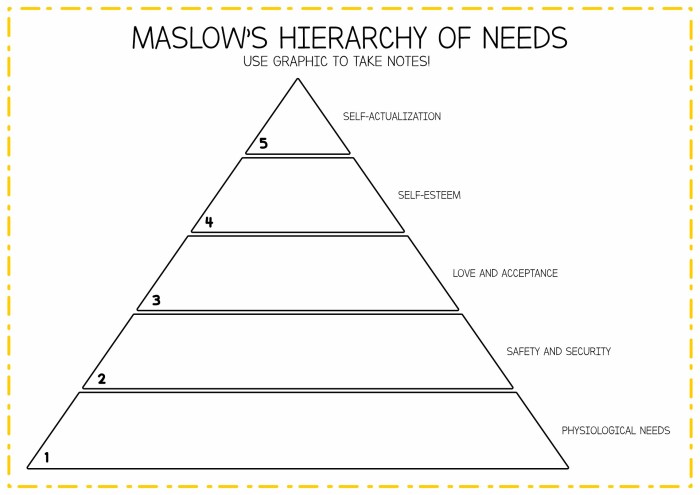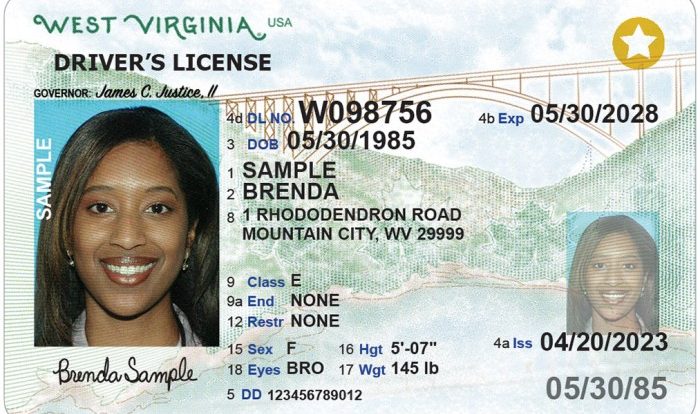The Maslow Hierarchy of Needs Worksheet is an invaluable tool for comprehending and applying Maslow’s groundbreaking theory of human motivation. This guide delves into the concept, structure, and practical applications of the hierarchy, empowering individuals and organizations to enhance their decision-making and achieve optimal outcomes.
Maslow’s hierarchy, a foundational concept in psychology, categorizes human needs into five distinct levels, each with unique characteristics and significance. Understanding these levels enables us to prioritize our aspirations and allocate resources effectively.
1. Maslow’s Hierarchy of Needs Overview

Maslow’s Hierarchy of Needs is a motivational theory proposed by Abraham Maslow in his 1943 paper “A Theory of Human Motivation.” It posits that human needs are arranged in a hierarchical order, with the most basic physiological needs at the bottom and the more complex psychological needs at the top.
According to Maslow, individuals must satisfy the lower-level needs before they can progress to the higher-level needs.
The hierarchy consists of five levels:
- Physiological needs: These are the most basic needs, such as food, water, shelter, and sleep.
- Safety needs: These needs include security, stability, and protection from harm.
- Love and belonging needs: These needs involve social interaction, intimacy, and acceptance.
- Esteem needs: These needs include self-respect, confidence, and achievement.
- Self-actualization needs: These needs involve reaching one’s full potential and living a meaningful life.
Maslow’s hierarchy is often represented as a pyramid, with the physiological needs at the base and the self-actualization needs at the top.
2. Using the Maslow Hierarchy of Needs Worksheet
A Maslow Hierarchy of Needs worksheet is a tool that can help individuals identify their needs and track their progress towards satisfying them. Worksheets can be used for personal development, career planning, or workplace motivation.
To complete a worksheet effectively, follow these steps:
- Identify your needs: Write down all of the needs that you feel are important to you, both at work and in your personal life.
- Categorize your needs: Use Maslow’s hierarchy to categorize your needs into the appropriate levels.
- Prioritize your needs: Decide which needs are most important to you and focus on satisfying those needs first.
- Develop a plan: Create a plan for how you will satisfy your needs. This may involve setting goals, taking action steps, or seeking support from others.
- Track your progress: Regularly check in with yourself to see how you are progressing towards satisfying your needs.
3. Applications of Maslow’s Hierarchy of Needs: Maslow Hierarchy Of Needs Worksheet

Maslow’s hierarchy can be applied to various fields, including:
Education
Maslow’s hierarchy can help educators understand the needs of their students and create learning environments that are conducive to their success. For example, students who are struggling to meet their physiological needs (e.g., food, shelter) may not be able to focus on their studies.
Healthcare, Maslow hierarchy of needs worksheet
Maslow’s hierarchy can help healthcare professionals understand the needs of their patients and provide them with the best possible care. For example, a patient who is experiencing pain (a physiological need) may need pain medication before they can focus on their emotional needs.
Business
Maslow’s hierarchy can help businesses understand the needs of their employees and create workplaces that are motivating and productive. For example, employees who feel safe and secure in their jobs (a safety need) may be more likely to be engaged and productive.
Social work
Maslow’s hierarchy can help social workers understand the needs of their clients and provide them with the support they need. For example, a social worker may help a client find a job (a safety need) before they can focus on their emotional needs.
4. Limitations and Criticisms of Maslow’s Hierarchy of Needs

While Maslow’s hierarchy has been widely influential, it has also been subject to some criticism.
Limitations
- Cultural differences: Maslow’s hierarchy may not be applicable to all cultures. For example, some cultures may place more emphasis on social needs than on individual needs.
- Individual differences: Maslow’s hierarchy may not apply to all individuals. For example, some people may be more motivated by their need for achievement than by their need for love and belonging.
Criticisms
- Rigidity: Maslow’s hierarchy is often criticized for being too rigid. It suggests that individuals must satisfy their lower-level needs before they can progress to the higher-level needs. However, research has shown that people can often satisfy their higher-level needs even when their lower-level needs are not fully met.
- Lack of consideration for situational factors: Maslow’s hierarchy does not take into account situational factors that may affect an individual’s needs. For example, a person who is experiencing a crisis may have their lower-level needs (e.g., safety) temporarily override their higher-level needs (e.g.,
self-actualization).
Alternative theories
Several alternative theories have been proposed to challenge or complement Maslow’s hierarchy. These theories include:
- Alderfer’s ERG theory: This theory posits that needs are grouped into three categories: existence needs (physiological and safety needs), relatedness needs (love and belonging needs), and growth needs (esteem and self-actualization needs).
- McClelland’s achievement motivation theory: This theory focuses on three needs: the need for achievement, the need for power, and the need for affiliation.
- Herzberg’s two-factor theory: This theory posits that there are two types of factors that motivate employees: hygiene factors (e.g., salary, working conditions) and motivation factors (e.g., challenging work, recognition).
5. Designing a Maslow Hierarchy of Needs Worksheet
When designing a Maslow Hierarchy of Needs worksheet, it is important to consider the following elements:
- Clarity: The worksheet should be easy to understand and use.
- Comprehensiveness: The worksheet should cover all of the levels of Maslow’s hierarchy.
- Customization: The worksheet should be customizable to meet the individual needs of the user.
Here is a structured template for creating a comprehensive Maslow Hierarchy of Needs worksheet:
- Introduction: Provide a brief overview of Maslow’s hierarchy and its benefits.
- Needs assessment: Ask the user to identify their needs and categorize them into the appropriate levels of Maslow’s hierarchy.
- Prioritization: Ask the user to prioritize their needs and develop a plan for satisfying them.
- Reflection: Ask the user to reflect on their progress towards satisfying their needs.
The worksheet can be delivered in a variety of formats, including printable, digital, and online.
6. Evaluating the Effectiveness of Maslow Hierarchy of Needs Worksheets
The effectiveness of Maslow Hierarchy of Needs worksheets can be evaluated using a variety of metrics, including:
- User satisfaction: Are users satisfied with the worksheet and do they find it helpful?
- Progress tracking: Are users able to track their progress towards satisfying their needs?
- Goal achievement: Are users able to achieve their goals by using the worksheet?
Feedback from users is essential for improving the effectiveness of Maslow Hierarchy of Needs worksheets. By collecting feedback, you can identify areas for improvement and make changes to the worksheet accordingly.
Questions Often Asked
What are the limitations of Maslow’s Hierarchy of Needs?
While Maslow’s hierarchy provides a valuable framework, it has limitations. It may not be universally applicable across cultures or individuals, and it doesn’t account for situational factors that can influence needs.
How can I use the Maslow Hierarchy of Needs Worksheet in my workplace?
The worksheet can help you analyze employee motivation, create a positive work environment, and develop strategies for employee growth and satisfaction.
What are some alternative theories to Maslow’s Hierarchy of Needs?
Other theories include Alderfer’s ERG Theory, McClelland’s Theory of Needs, and Herzberg’s Two-Factor Theory.

